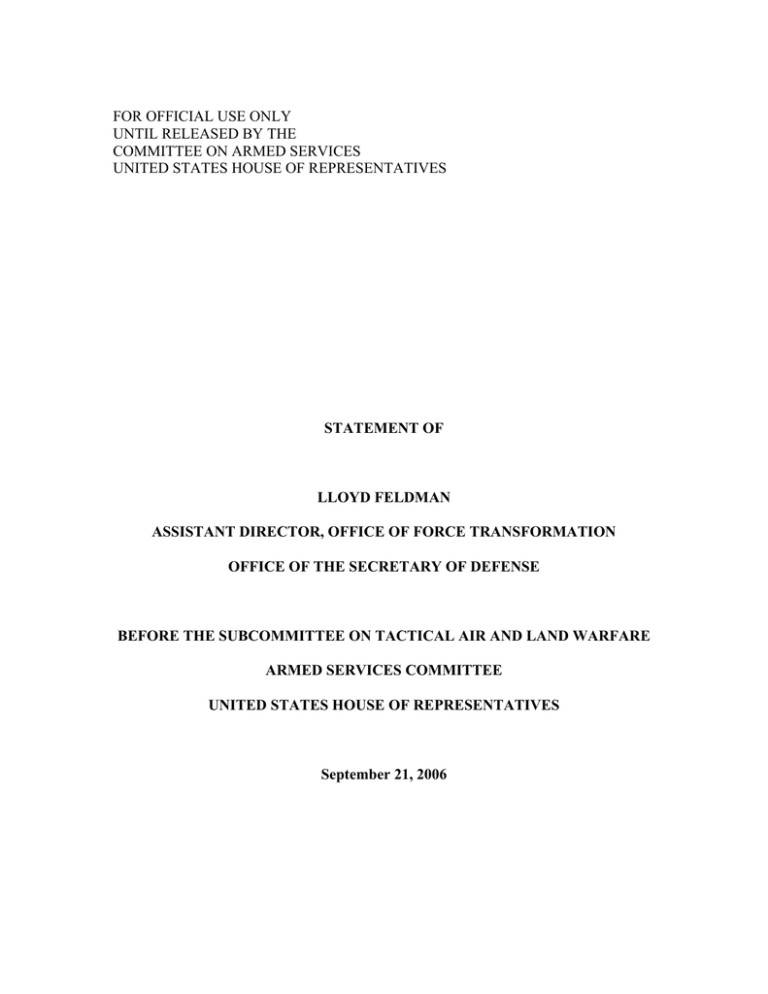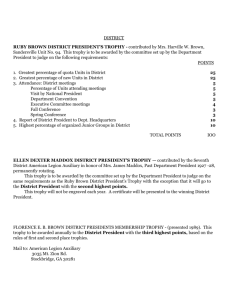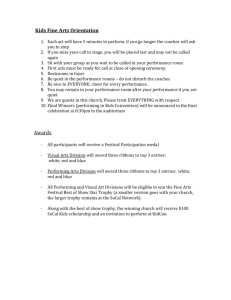FOR OFFICIAL USE ONLY UNTIL RELEASED BY THE COMMITTEE ON ARMED SERVICES
advertisement

FOR OFFICIAL USE ONLY UNTIL RELEASED BY THE COMMITTEE ON ARMED SERVICES UNITED STATES HOUSE OF REPRESENTATIVES STATEMENT OF LLOYD FELDMAN ASSISTANT DIRECTOR, OFFICE OF FORCE TRANSFORMATION OFFICE OF THE SECRETARY OF DEFENSE BEFORE THE SUBCOMMITTEE ON TACTICAL AIR AND LAND WARFARE ARMED SERVICES COMMITTEE UNITED STATES HOUSE OF REPRESENTATIVES September 21, 2006 STATEMENT OF THE ASSISTANT DIRECTOR OF FORCE TRANSFORMATION OFFICE OF THE SECRETARY OF DEFENSE BEFORE THE SUBCOMMITTEE ON TACTICAL AIR AND LAND WARFARE ARMED SERVICES COMMITTEE UNITED STATES HOUSE OF REPRESENTATIVES September 21, 2006 Chairman Weldon, Members of the Subcommittee, I’m honored to address the Subcommittee, and I am grateful for the opportunity to discuss the Office of Force Transformation’s innovative work on Project Sheriff and its demonstration of the Trophy Active Protection System. I have included as part of my written testimony four addendums. They include a chronology of relevant events related to the initiative; the process, analysis and rationale that led to the selection of the Trophy system; how the Trophy system was integrated onto an Army Stryker vehicle; and relevant testing information and results. The United States military finds itself today engaged in a Long War against multiple types of terrorist cells and other malignant non-state actors whose organizations are amorphous and ever changing. Confronting this threat requires shedding long held assumptions regarding our preferred methods of warfare and how our forces go about finding, tracking and targeting an elusive enemy who hides among civilian populations and exhibits no moral inhibitions to sacrificing innocents to achieve their aims. Confronting this enemy requires waging a War against Individuals. Successfully fighting this type of war requires a willingness to embrace new types of capabilities, vastly different tactics and new ways of acquiring assets optimized for this fight. That is, in part, what the Office of Force Transformation was established to do for the Department of Defense. The office serves as an internal catalyst for change. It champions those types of concept-technology pairings that are potential “game changers” in terms of how their future use will fundamentally alter battlefields of tomorrow. OFT operates at the intersection of unarticulated needs and non-consensual change. As a result, the office has a wide field of maneuver—a sanctuary—where new ideas and innovations can be experimented outside of the restricted confines of established requirements and acquisition hierarchies. It generates new knowledge and creates unique experimental articles for use by the combatant commands to enable an alternative path for the department to address future needs. As the pace of change accelerates and we race headlong into the information age, so must the department’s transaction rate also accelerate as we create new capabilities and options from “learning.” Stagnation of institutional learning comes at the expense of future competitive advantage, flexibility and relevance. As we continue to perfect the familiar and the comfortable “known,” we must continue to develop methodologies which accelerate learning and decrease the department’s overall level of strategic risk. If we are to take full advantage of what the information age offers, we must adopt a much faster acquisition and generational cycle rate across the military. The costs imposed by staying with slower turnover in systems—a technology cycle rate that currently runs 15 to 25 years for U.S. forces—is likely to be technological surprise, asymmetric threats and victimization in the measures/countermeasures engagement. One method that OFT uses to speed the creation of new knowledge across the force is through the idea of Concept-Technology Pairings. The objective is to operate in advance of requirements. These should not be considered programs and they are far removed from normal Pentagon acquisition processes. The intent is the early experimentation with surrogate technologies around a loosely defined concept tied to recognized gaps in current capabilities. To date, OFT has launched Concept-Technology Pairings in the areas of Operationally Responsive Space; Project Sheriff; Redirected Energy; Stiletto/Wolf PAC; and Sense and Respond Logistics. Concept-Technology Pairing offers a glimpse of what a future, robust capability might be. These pairings are not expected to be 100 percent effective and we should not be surprised if some result in failure. The product here is learning in conjunction with warfighter needs. New knowledge can be best advanced through a process of trial and error. But where the pairings approach differs from other department efforts like Advanced Concept and Technology Demonstrations (ACTDs) is one of intent. ACTDs are expected to enter into production at the completion of their three-year phase. As such, a premium is placed on “finding” or “selecting” for ACTDs only those candidates that offer a near-term promise of being produced. The result is a collection of relatively well understood technologies and not those more on the cutting edge of innovation. The output from concept-technology pairings, however, is new knowledge that in turn leads quickly into another more refined version of the concept. Successive iterations of the concept in essence bring that future forward and allow warfighters to use and shape near-term opportunities for concepts like Sheriff that were previously relegated to an illdefined future. By getting these capabilities into the hands of war fighters early and allowing them to experiment with successive iterations of the capabilities allows for the rapid co-evolution of tactics/concepts and leads to a level of operational dexterity that promotes innovation across the forces. The Sheriff Project and the follow-on Wolf Pack Platoon Project are Office of Force Transformation experiments that pair leading edge operational concepts for complex, irregular warfare with state of the art enabling technology. The Project Sheriff initiative was started in 2004, and addressed urgent warfighter needs for integrated sensors, lethal and non-lethal weapons, and force protection. It is designed to rapidly and iteratively experiment with pioneering tactics and technology through a close interaction between innovative warriors and a supporting community of industry, government laboratories, and universities. These rapidly executed experiments are designed to (1) create and test an integrated prototype in no more than 18 months that fit into an overarching operational construct, (2) create a low cost experimental venue where warfighters and the supporting science and technology community closely cooperate and (3) complement and inform the more deliberate acquisition process by identifying warfighter needs and experimenting with potential technological solutions, tactics, procedures and policies (e.g., employment of non-lethal and autonomous systems). The ultimate goal is to be a catalyst for meeting the emerging needs of ground battle in irregular warfare, counterinsurgency and security and stability operations. The project also specifically addressed U.S. Central Command’s urgent needs in Iraq and Afghanistan. These needs were formally expressed in a Time Critical Joint Operational Needs Statement (JONS) developed by the Multi-National Corps Iraq and endorsed by Central Command in 2005 for capabilities to be provided by the Sheriff Project. Project Sheriff and the new, follow on Wolf Pack Platoon Project are designed to specifically address the: • Compressed strategic, operational and tactical levels of war and intelligence; • Problem of identifying combatants intermixed with non-combatants; • Need for in-depth situational awareness; • Blurred distinction between combat and police action; • Requirement for multiple levels of graduated responses and precise target discrimination; • Increased Command, Control, Communications, Computers and Intelligence, Surveillance and Reconnaissance (C4ISR) to create tactical options against a distributed threat; • Digital, organizational and intelligence divide found between tactical units at the edge of battle and technology enabled, higher headquarters; • Increased threat of Improvised Explosive Devices, Rocket Propelled Grenades, snipers and small arms ambushes. To meet this new, highly dynamic and evolving threat to American forces, Project Sheriff’s goals were to: (1) Experiment with innovative concepts of operation, tactics, techniques and procedures that would both inform and be informed by potential technological enablers. (2) Integrate commercial off the shelf or mature technologies into complementary, combined arms solutions mounted on a light armored vehicle under compressed timelines. (3) Combine non-lethal directed energy—High Power Millimeter Wave technology, High Power White Light, Laser Glare Aversion for Optical Denial, Long Range Acoustic Device—with sensor enabled Active Protection, lethal response, and electronic warfare. (4) Develop the synergistic, combined arms employment of lethal kinetic energy and non-lethal directed energy weapons in compartmented urban terrain. (5) Combine active protection, lethal gunfire and electronic warfare to meet the threat of RPGs, snipers, and IEDs. (6) Serve as an active denial technology proof-of-concept in anticipation of fielding longer-range and more capable directed energy technologies. (7) Test rapidly and rigorously in an operationally realistic environment prior to deployment. (8) Complete required bio-effects research, legal, and policy reviews prior to deployment. (9) Increase learning and inform acquisition programs at minimal expense. The Active Protection System (APS) is one component of this combined arms approach that aims to fundamentally enhance capabilities for ground battle in complex urban environments. In addition to IEDs, RPGs are an increasingly sophisticated and prevalent threat in irregular warfare. An active protection system enables light armored vehicles to survive a first shot from a hidden enemy while the Trophy Active Protection System was selected as the most promising near term capability for experimental assessment based on a government laboratory evaluation. Initial U.S. defense laboratory testing of Trophy began this year. The ongoing Wolf Pack Platoon Project will continue a testing program that builds on these initial successful tests and that validates extensive Israeli testing and U.S. industry evaluations. The aim of this testing program is to: • Evaluate near term active protection technology to rapidly meet immediate warfighter needs; • Determine how APS fits into a combined arms approach to the RPG, IED, sniper and small arms ambush threat, and; • Conduct experiments led by warfighters to advance operating concepts and refine needs that will inform the development of any active protective system. My testimony does not address the issue of the deliberations that led to the removal of the Active Protection System from FSEP, as the Office of Force Transformation is not a member of the Joint Rapid Acquisition Cell. Representatives from the Office of Force Transformation were invited to numerous meetings with Dr. Buhrkuhl and the JRAC and we presented our views in the course of these discussions. I thank the committee for its interest in OFT’s Sheriff and follow on efforts and its continued support for department-wide transformation. I look forward to providing more detail to any additional questions you may have. Project Sheriff/Trophy Active Protection System Chronology of Events: July- November 2004--Naval Surface Warfare Center, Dahlgren Division conducted a review of available and potentially available Active Protection Systems for use on the FSEP vehicle. The initial study recommended the Chang Industries Full Spectrum Active Protection Close-in Layered Shield (FCLAS) system, but costs to accelerate to meet FSEP schedule were too steep ($18 million). Army efforts were advancing to determine final APS system for the Future Combat System, including a proposed demonstration test series in June 2005. March 2005--Program Manager-Close Combat Systems (PM-CCS) selected by US Army to be the service’s lead material developer for FSEP. June 2005--APS demonstration series cancelled. June 2005--NSWCDD and PM-CCS conduct an official market survey with vendors of potential APS systems for FSEP. This resulted in a unanimous recommended selection of Trophy to integrate with FSEP. August 2005--PEO-GCS (Mr. Kevin Fahey) was briefed on the selection of Trophy as a potential FSEP APS solution. Mr. Fahey approved to use existing PEO-GCS contracts with GDLS to conduct FSEP Stryker/ Trophy integration. September 2005--NSWCDD and PM-CCS negotiated with GDLS and Rafael to integrate Trophy aboard FSEP. The contract was funded by OFT through NSWCDD to PM-Stryker Brigade Combat Team (PM-SBCT). October-December 2005--NSWCDD and PM-CCS conduct detailed analysis of Trophy capabilities, integration and design. Secret briefings by Rafael and GDLS detail Trophy capabilities and level of testing conducted by Rafael for Israeli Ministry of Defense. December 2005--Trophy system integrated aboard FSEP at NSWCDD to demonstrate fit and to conduct electromagnetic testing. Electromagnetic testing results demonstrated that the Trophy had no susceptibility or interference with other systems. Testing also demonstrates that Trophy radars present no hazard to personnel. January 2006--Decision made that APS would not be functionally demonstrated as part of the FSEP LUA due to concern over potential FSEP vehicle damage and safety constraints. APS demonstration on a separate Stryker vehicle recommended and undertaken. Trophy removed from FSEP and returned to Israel. February 2006--NAVSEA and IDF update existing Data Exchange Agreement (DAE) allowing official Government to Government information exchange on Trophy. This DEA allowed full access to IMOD data. February 2006--Rafael integrates Trophy onto Israeli Stryker to mimic exterior layout of FSEP so testing results would be applicable to FSEP effort. Use of Israeli Stryker allows Trophy design to be integrated quickly and saves time (estimate 2 months). Rafael begins series of tests to verify Trophy functionality and personnel safety. Rafael conducts hazard tests. Additionally, RPG engagement tests were conducted similar to those to be conducted at NSWCDD. NSWCDD engineers were either personally present during these tests or verified the tests results and conclusions. February 2006--NSWCDD, GDLS and Rafael develop a plan to demonstrate Trophy in both static and dynamic environments. Testing gathers data to demonstrate Trophy capabilities and provides a body of data owned by US government. March 2006--US Interim Hazard Classification for Trophy warheads developed based on data from the IMOD and Rafael. IDF Stryker then shipped to US via USAF transport aircraft. Testing and demonstration work began at NSWCDD on 21 March 2006. Testing included both a stationary and moving vehicle. Tests were conducted with both instrumented and live Trophy warheads for analysis. Of the 38 tests conducted, 35 were kills or rated as kills, for a success rate of 92%. The tests were conducted against RPG 7 missiles with inert warheads. These RPGs had the same velocity and flight profiles as live RPGs and were certified by NSWCDD EOD techs as being representative of a fully operational missile. The Trophy demonstration was a dramatic success and indicated to the team that Trophy performed as intended. April 2006--Rafael GDLS and NSWC Dahlgren detail all testing and analysis conducted to support FSEP. Includes information on further testing Rafael was conducting for the IMOD. This presentation was made at the secret level on 28 April to representatives of the Defense Operational Test and Evaluation Office and on 1 May with representatives of the Army Test and Evaluation Command and Marine Corps System Command. At the 1 May meeting a plan was presented for the Trophy ‘way ahead’ to include an engineering design for an autoloader system. April 16, 2006--US Army formally requests to OSD - Joint Rapid Acquisition Council (JRAC) that Trophy be removed from FSEP. May 11, 2006--JRAC considers US Army request to delete APS requirement from FSEP Spiral 1 vehicle. The decision was to get CENTCOM validation of the APS requirement given the time, schedule and cost impacts discussed at this meeting. May 2006--PM-SBCT was selected as the US Army PM for FSEP development. May 2006--NSWCDD engineering team reviews extract data from 30 March demonstration testing. Based on US Army approved request to remove Trophy from FSEP, OFT and NSWCDD alter future FSEP strategies to include Trophy in a further developmental process. 1 June 2006--JRAC announces decision, based on CENTCOM feedback, to approve Army’s recommendation to slip Trophy to a later spiral. July 2006--OFT and NSWCDD began negotiations with Rafael to procure one (1) operational Trophy system with autoloader capability and support needed for further test and evaluation. September 2006--RFP for procurement of 1 operational Trophy system with autoloader and engineering support for testing provided to Rafael. Process, Analysis and Rationale that led to selection of the Trophy system for testing and evaluation. On 28 and 29 June representatives from 6 different Active Protection System vendors briefed a combined NSWCDD and PM-CCS team in Crystal City, VA on the capabilities of their systems. Each vendor was required to provide information on their system and discuss with the selection team what capabilities they would be able to provide in order to meet the FSEP timeline of having an integrated system by 31 December 2005. The systems were evaluated on the vendor’s ability to meet the FSEP Urgent Operational need. The following evaluation criterion was established: Category Operational Concept Definition Fundamental soundness of technical approach and maturity of technology Procurement Cost per side Integration Cost Cost to purchase one proposed system for Spiral 0 Cost to integrate and install system on vehicle beginning on delivery date and ending when fully integrated, operational, and ready for test. Able to delivery and integrate by 31 DEC 05 Assessment of completed system tests and availability of safety analysis Total weight of system (with ammunition) for Spiral 0 Topside and inside volume not interfere with current FSEP layout Voltage (AC or DC) and amperage requirement System interior and exterior cooling requirements Defeat RPG fired from near range, near 360 degree coverage on the move Engineering data must be available for integration Schedule Past testing and safety analysis completed Weight Size Power Requirements Cooling Requirements System Performance Availability of models and interface documentation How was the Trophy System Integrated onto an Army Stryker Vehicle? Two integrations of the Trophy system were performed to support the FSEP program: 1. The first was the integration of the Trophy onto the FSEP Stryker vehicle conducted in Dec 05. In this integration the Trophy launchers were mounted to the side of the FSEP vehicle. Structural analysis and testing of the launcher mounting points verified that the Stryker hull would not be adversely affected by the Trophy system. The Trophy search radar systems were mounted on each side and at the front and rear of the vehicle in special mounting brackets. Trophy on the FSEP Stryker The internal components of the Trophy system were integrated as part of the FSEP system and were mounted in racks and positions suitable for employment in the FSEP vehicle. The Trophy system was powered by the FSEP system generator. No additional electrical power requirements were needed. 2. The second FSEP Trophy integration was on the Israeli Defense Force Stryker. The integration was conducted to support the tests and demonstration planned at NSWCDD in March 06. The exterior installation of this system was identical to that on the initial FSEP vehicle installation. The interior components of the Trophy system were rack mounted inside the vehicle to facilitate the necessary testing and analysis. Again, in this installation the Trophy system ran exclusively on vehicle power. No additional power systems were needed. Additionally, all US Army agencies involved in the FSEP Project were invited and encouraged to participate throughout the entire testing & demonstration process. FSEP Trophy on the IDF Stryker In addition to the Trophy integration done to support FSEP, GDLS and Rafael have completed a concept study and analysis of a Trophy installation that would meet all Stryker Infantry Carrier Vehicle requirements. What Relevant Testing was Conducted? Multiple tests were conducted on the Trophy system as part of the FSEP project. The table below lists the tests and the results: The Trophy integrated on the FSEP Stryker Test Result Fit and Function Trophy installed and fit as designed. System functioned as expected. No susceptibilities on Trophy Electromagnetic Vulnerability (Tailored Environment) Trophy caused no effects to any ammunition types expected Hazards of aboard FSEP. Electromagnetic Radiation to Ordnance (HERO) Below personnel exposure limits. Hazards of Electromagnetic Radiation to Personnel (HERP) Electromagnetic No interaction of Trophy with other systems on board vehicle compatibility The Trophy system integrated on the IDF Stryker Test Result Fit and Function Trophy installed and fit as designed. System functioned as expected. Flash Signature The flash signature seen through the periscopes of the vehicle would not cause ocular damage to personnel inside the vehicle. Flash outside of the vehicle would not cause ocular damage. Acoustic Signature Adequate hearing protection is provided by the required standard hearing protection worn inside the vehicle. Blast Overpressure Minimal blast overpressure inside of the vehicle. Trophy is designed to be operated with open hatches. Debris Protection Witness panels proved that blast shields protected crew hatch areas from debris. Trophy is designed to be operated with open hatches. 38 tests were conducted with inert RPGs being fired at (or in close proximity to) the vehicle. Multiple tests were conducted firing 2 RPGs nearly simultaneously – one to each side of the vehicle. Live Fire tests conducted at NSWCDD The tests were conducted against RPG -7 missiles with inert warheads. These RPGs had the same velocity and flight profiles as live RPGs and were certified by NSWCDD EOD techs as being representative. RPGs were fired remotely from 100 meters away using test stands. 12 of the 38 tests were conducted as the vehicle was moving at approximately 25mph. 35 of 381 tests were rated as a success. System identified, tracked and engaged threat2 RPGs. Notes: (1) Tests using a “live” Trophy engagement round accounted for 6 tests with 4 countermeasures firing. All other Trophy tests were deemed either a successful or a failure by using tracking cameras in place of the “live” Trophy countermeasure and analyzing the system data with the video coverage with modeling and simulation to predict the outcome. (2) System successfully distinguished between RPGs aimed to strike the vehicle and RPG’s that would miss the vehicle. In addition to the tests noted above a structural test was conducted at Aberdeen Proving Ground to determine that the loading imposed by a Trophy warhead would not overstress a Stryker vehicle. A 1/2 kg charge of C-4 was detonated in place of the Trophy warhead and no structural damage was noted.







